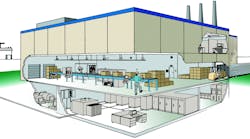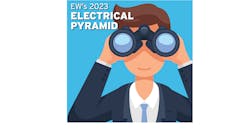Sure it's ugly out there. But when business goes sour, it can actually be a good time to catch some competitors sleeping, or others who have cut back on some of their core strengths. By moving fast, you can hone the differences between your firm and its competitors and grab some market share — even before business comes back. One of the best ways to do this is to offer more value-added services than your competitors. A value-added service is an investment that you have made in your company that makes life easier for your customers or helps you do a better job of performing as a distributor of electrical supplies.
Value-added services help differentiate your company from its competitors, and it's important to regularly take stock of the services your company offers — as well as those of your competitors. Take a close look at the services a competitor is unwilling or unable to perform and you may find that your company can package some of them for your own mix of customers. The company with the best package of value-added services will win its unfair share of the market most of the time.
This article will teach you how to analyze the value-added services that you and your competitors focus on. It also offers a four-step strategy that you can use to establish your company as the primary source of electrical supplies in your market. It's a strategy excerpted from the revised edition of “The Electrical Marketers Survival Guide,” a book and training program that Electrical Wholesaling will republish later this year. Excerpts from this book will be published regularly over the next few months.
Let's take a look at the strategy's four key elements:
-
Scope out the marketplace
-
Examine your company's package of value-added services
-
Evaluate the competition
-
Develop counter-strategies based on what you have learned
- Scope out the market
The first thing to do is examine the various channels for electrical supplies in your market and how their value-added services differ. One of the most valuable tools for evaluating these is the “Electrical Marketplace Pyramid” (page 31). Many companies have used the Electrical Pyramid since Electrical Wholesaling first published it in 1994 to analyze the key channels for electrical products in today's electrical industry. EW's Oct. 2008 issue offered an analysis of the Electrical Pyramid. You will probably be surprised at how many different types of companies other than full-line electrical distributors sell electrical products. Worksheet #1 on this page will help you do your own analysis of the role these various channels play in your market.
The competitive advantages of each of these channels of distribution are often tied to distinct package of value-added services they use to sell electrical products. For instance, a small family-owned electrical supply house may have a core group of dedicated inside salespeople who are of enormous technical assistance to customers, while the home center down the road may rely on a constantly changing lineup of salespeople with no particular expertise in electrical supplies. Yet that same home center will score points with customers because it's still a source of certain electrical supplies long after that distributor has closed up shop.
Or take that voice/data/video (VDV) wiring specialist that invests in all sorts of oddball conductor and insulation varieties. That company may be just the ticket for a customer that needs an unusual wiring harness that no electrical distributor in town would stock. But a full-line electrical distributor may be that customer's first call for job-site delivery of bulk wire.
Each of these scenarios is an example of a distributor of electrical supplies winning an order because they provide some extra service not offered by another competitor.
- Examine your company's package of value-added services
On page 29 is a list of 50 value-added services that you can use to evaluate your company's service capabilities. Another way of maximizing your company's sales efforts is to make sure your salespeople know how to sell “add-on” items to all orders. As you will see in EW's Guide to Add-On Sales on the previous pages, it means that when customers place orders, salespeople always ask if they need related products. For instance, if a customer orders electrical boxes, the salesperson should always ask if they also need box covers, mounting hardware, wiring devices, wire connectors, fittings and tools.
- Evaluate the competition
Your company should be doing a regular analysis of the strengths and weaknesses of key competitors. Worksheet #2 on this page can help you organize key competitive information. Visit the websites of all competitors, if you haven't done so yet. While an awful lot of websites in the electrical industry are still little more than electronic promotional brochures, you will be surprised at how much company data you may find. Always click on the “About Us” or “Company History” links for background. Don't forget to Google competitors, and if they are larger companies check them out on www.hoovers.com, which offers some free basic company profiles and more data on firms for a fee. Customers are also obviously another great source of information on competitors. If any of your employees have developed close personal relationships with customers, see if you can fill in some of the blanks on these worksheets with information from this source.
- Develop counter-strategies based on what you have learned
Now that you have identified what you and your competitors do best, it's time to sit down with your key employees and use what you have learned to develop a battle plan. If your company can afford it, this might be a good time to organize a company retreat for a few days so that everyone can get away from the phones and focus on this challenge.
If a company retreat does not work into your plans, meet with your key managers during work hours. For either type of meeting, distribute your research findings to key department heads who will attend, and then ask them to report on what their departments can do to improve your company's package of value-added services. For instance, your warehouse manager may see some new ways that you can stage orders for large construction projects to simplify jobs for customers.
Evaluating the value-added services that you and your competitors offer is one of the most valuable exercises that your company can invest it in. With all of the new channels of distribution now on the radar screen, the value-added services you offer may very well become the key to your future success and survival.
50 Great Ways to Add Value
-
Having the right inventory in stock at the right time.
-
Providing customers with information on new products.
-
Knowing the National Electrical Code changes and being able to help customers learn about their impact on product features and applications.
-
Offering customers a line of credit.
-
Delivering products to the job site or plant.
-
Providing accurate, timely pricing information.
-
Conducting business in an ethical, professional manner.
-
Making emergency deliveries.
-
Having a 24-hour hot line.
-
Organizing counter days, in-house training or trade shows so customers can meet with manufacturers.
-
Being open on Saturdays.
-
Accepting Visa, MasterCard or Discover to help out smaller customers with low credit limits.
-
Handling returns and defective products.
-
Staging orders on big projects.
-
Training customers on new products.
-
Calling on customers at their convenience in their place of business with trained salespeople.
-
Offering customers a single source of supply for hundreds of manufacturers.
-
Offering customers advice on the bookkeeping end of their businesses.
-
Putting together a “system” or package of products that work together.
-
“Kitting” products for manufacturing plants that need a certain group of electrical or electronic components to be built into the products they make.
-
Helping customers with problem-solving and trouble-shooting applications.
-
Knowing local building codes and practices.
-
Identifying material and its source.
-
Standing behind the products you sell.
-
Providing substitutions.
-
Doing take-offs for customers
-
Making extensive quotations for customers' project bids.
-
Demonstrating products.
-
Coordinating just-in-time deliveries to manufacturing plants.
-
Keeping customers competitive.
-
Providing product information, catalogs and technical bulletins in either printed or online form (PDFs, electronic catalogs, etc.).
-
Having capable in-house salespeople to handle questions, expediting and repeat orders and product specialists to answer technical questions.
-
Giving third-party recommendations on products you sell.
-
Offering customers who use you as their main source of electrical supplies special incentives such as dating, special delivery, training, etc.
-
Bringing manufacturers' reps or field salespeople to customer job sites to help with product-related problems.
-
Sourcing hard-to-find products for customers.
-
Being a dependable, local source of supply.
-
Giving customers report cards so they can grade your company on various aspects of your service.
-
Taking customers as your guests to local electrical shows so they can learn about new products on the market.
-
Organizing trade fairs at customer locations with some of your key suppliers.
-
Saving customers shopping time by stocking non-electrical job-site supplies such as water coolers, ladders, foul-weather gear, maps, shovels, etc.
-
Offering a tool-rental program for more expensive power equipment such as power benders and generators.
-
Providing industrial plants with full-time, on-site tool crib stocking.
-
Working with distributors of other construction and industrial supplies to provide customers with a one-stop source of supply for MRO-oriented products.
-
Providing key customers with demonstration models of tools or samples of new supplies so they can evaluate the products under job-site conditions.
-
Providing accurate computerized information for customers.
-
Offering customers e-mail as an option to send in orders, request information, etc.
-
Taking orders through electronic data interchange (EDI) to cut down on paperwork errors.
-
Maintaining a website that offers 24-hour access to product information, order status, company services, etc. Give yourself an extra point if you utilize IDEA's Industry Data Warehouse (IDW).
-
If you have expertise in-house, helping key customers build their own websites.
What other value-added services does your company offer? List them below and give yourself a point for each. (Use more paper, if needed).
51. _________________________________________________________________________________________________________________________________________________________
52. _________________________________________________________________________________________________________________________________________________________
Scoring
Get out a pen or pencil and check off the practices your company presently uses. No points for “planning to, someday,” but if your company is developing one of these strategies, give yourself a half-point. Count up the checks, and don't forget the bonus points, as noted. Score one point for each check.
A score of 40 or more
Your company is a pioneer and clearly ahead of the pack, using the latest thinking in the electrical wholesaling industry. Don't stop now, though. Work with your employees to come up with 50 more ideas to polish your company's performance.
A score of 30 to 39
You are on your way, but there's room for improvement. Get your company up to the next level, and then start working on those 50 new ideas.
A score of 29 or less
Some competitors have gotten a jump on you in molding their companies into professional marketing organizations. It's time to sit down with your key people and take a hard look at what it will take to catch up.
Worksheet 1 — Local Market Channels
National and semi-national chains in my market: (Rexel/Gexpro, Graybar, WESCO, CED and Sonepar)
___________________________________________________
___________________________________________________
___________________________________________________
___________________________________________________
Biggest regional players in the market: (Multi-state companies like Border States Industries, City Electric Supply (CES), Crescent Electric Supply and Summit Electric Supply; or large regionals such as California's Independent Electric Supply and OneSource Distributors; the Pacific Northwest's Platt Electric Supply and North Coast Electric Supply; and the Southeast's Mayer Electric Supply.)
___________________________________________________
___________________________________________________
___________________________________________________
___________________________________________________
Five strongest independent electrical distributors:
1. _________________________________________________
2. _________________________________________________
3. _________________________________________________
4. _________________________________________________
5. _________________________________________________
“Hybrid” distributors: (Companies that are not totally electrical but not product specialists, such as Grainger or Fastenal)
___________________________________________________
___________________________________________________
___________________________________________________
___________________________________________________
Product specialists getting some market share (check out EW's Electrical Pyramid to make sure you don't forget any of the niche players in your market area)
Home centers making an impact:
___________________________________________________
___________________________________________________
___________________________________________________
Other alternate channels now on the radar screen:
___________________________________________________
___________________________________________________
___________________________________________________
How Many Electrical Distributors Are Out There?
By EW's estimates, more than 2,500 full-line “traditional” electrical distributors and distributors that focus on selling niche products operate more than 8,000 total locations. This estimate includes the 475 members of the National Association of Electrical Distributors and the 4,400 branches they operate. Total sales volume for NAED distributors is an estimated $31 billion. The industry's largest buying/marketing groups (Affiliated Distributors,IMARK/Equity/EDN) have an estimated 1,263 distributors with 3,292 locations as members in North America.
Electrical Wholesaling's Guide to Add-On Sales
One of the most effective methods to boost a distributorship's sales is to make sure salespeople see additional sales opportunities when they surface. Below are some simple reminders that they can use to add products to orders. When customers order products in the left column, salespeople should ask them if they need the related products listed in the right column.
Worksheet 2 - Competitor Analysis
Company name _____________________________________
Street address ______________________________________
Town/City ____________________ State______ Zip _______
Phone number ______________________________________
Website _____________________________
# of locations ____________ # of employees ____________
# of field salespeople _____ # of inside salespeople _____
Estimated total sales volume: (Break down by customer type if reliable figures are available)
___________________________________________________
___________________________________________________
___________________________________________________
Buying/marketing group _____________________________
Primary customers __________________________________
Estimated market share by each of these customers (If reliable figures are available)
Electrical contractor ________ Industrial MRO ________
OEM _________ Utilities ________ Government _______
Retail ________ Other __________
What services does this company provide that my company does not?
1) _________________________________________________
2) _________________________________________________
3) _________________________________________________
What services does my company provide that this company does not?
1) _________________________________________________
2) _________________________________________________
3) _________________________________________________
Top managers or salespeople
Name ______________________________________________
Years with company __________________________________
Industry experience _______________________________________________________________________________________
Strengths _________________________________________
Weaknesses ________________________________________
Name ______________________________________________
Years with company __________________________________
Industry experience _______________________________________________________________________________________
Strengths _________________________________________
Weaknesses ________________________________________
Name ______________________________________________
Years with company __________________________________
Industry experience _______________________________________________________________________________________
Strengths _________________________________________
Weaknesses ________________________________________








